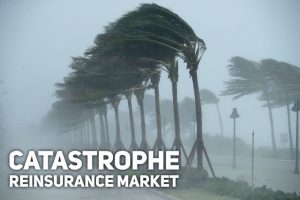Extreme Weather, Climate Change and What it Means for Reinsurance Markets
Tyler J. Scott, Research Analyst
What is Catastrophe Reinsurance
How and Why does Versant use it in its Investment Strategy
Reinsurance is purchased by primary insurers to reduce exposure to the financial risks associated with issuing certain insurance policies. One of the most prominent consumers of reinsurance policies are the primary insurers of catastrophe events. Catastrophe events are extreme events that are unlikely to occur frequently, but when they do, result in significant losses.
The primary insurers then pass along a portion of the tail risk to the reinsurers in return for a portion of the primary insurance premiums. Without reinsurance, the full financial burden of claims after a significant catastrophe event would be on the primary insurer. They would have to finance this from operating cash flow, debt financing or liquidating assets. Working with reinsurers allows for the primary insurers to hedge their business model, similarly to how an airline company will secure a long-term jet fuel contract to take the commodity price volatility out of the equation.
Reinsurers negotiate the largest share of the premiums they can for the tail risks that they are taking on. They are incentivized to ensure the portion of the premiums they receive is compensatory for these risks. The reinsurers often are not affected when smaller catastrophe events occur. Only when catastrophe events reach a certain financial level does the reinsurer have to bear its portion of the cost of the claims. This means that reinsurers are providing compensation to people and property in the most extreme and severe weather events.
Versant Capital Management invests in the reinsurance catastrophe market because of the attractive, real returns these insurance premiums offer. The risks associated with these investments are tied to the extreme and severe weather events, not traditional equity or fixed income markets. For these reasons, reinsurance investments have become a core component of Versant’s portfolios.
Climate Change Perspective
Climate change is a major topic in the world today. Scientists explain that climate change is occurring because gases in the atmosphere can have what is known as a “greenhouse effect”. The greenhouse effect is the result of certain gases warming the planet’s surface to a temperature above what it would be without its atmosphere. The earth’s natural greenhouse effect is what allows us to support life on earth.
Since the industrial revolution, human activities — namely, burning of fossil fuels, deforestation and urbanization — have caused a substantial increase in greenhouse gases present in our atmosphere. By all indications our planet is seeing increases in temperatures related to human activity.
However, today’s scientific thinking about the correlation of the increased temperatures and extreme weather events is currently speculative and is a separate discussion from that of climate change.
Climate vs Weather in the Context of 2017’s Extreme Weather Perils
2017 was a newsworthy year for extreme weather events. The U.S. experienced four hurricanes that made landfall. A significant earthquake occurred in Mexico, and California experienced some of its worst wildfires on historical record. These events caused significant damage to infrastructure and upended people’s lives. Across the country and abroad, people came together to support damaged communities. Many in the news media pointed at climate change as a cause for these events. However, the scientific community, cannot attribute a cause and effect relationship between climate change and any individual weather-related catastrophe.
Specifically related to hurricanes, U.S. historical records of both hurricane landfall data and insurance losses due to such events indicate that 2017 was not nearly the outlier as perceived by many. In fact, when a longer time horizon is observed, we can see that the decade from 2008 to 2017 had approximately 40 percent fewer hurricanes that made landfall than the decade from 1998 to 2007. (Source: NOAA HURDAT).
Even more apparent, prior to Hurricane Harvey, the U.S. had nearly twelve consecutive years without a major hurricane landfall. This perspective helps us understand that while 2017 saw significant peril events, scientific data doesn’t attribute this extreme weather to climate change.
Satellite data on storm systems over the ocean basins is available only since 1980. Such a limited amount of data does not provide scientists sufficient evidence to attribute extreme weather events to climate change. For example, there has not been an increasing trend in the amount of accumulated cyclone (hurricane) energy from global satellite records. However, there have been indications of an increase of Category four or five hurricanes in the Atlantic and North Indian Oceans. Other indications are that the number of hurricanes may continue to decrease. The net effect of these indications may be close to zero regarding future hurricanes making landfall and causing infrastructure damage. (Source: Journal of Climate)
Today’s science points to the natural variability of the weather system as the primary driver of extreme weather, and we may continue to see these events occur at a similar frequency to past events.
How Do Extreme Weather Events Apply to Reinsurance Investments?
- The reinsurance fund purchases quota share contracts, which are repriced Versant does not commit capital that depends on long-term climate projections, but rather, on the variability of the weather.
- What causes extreme weather is the amount of heat in the ocean and differentials between water and air temperatures. These differentials are readily measurable. This measurability allows reinsurance companies to assess risk and to develop a sustainable business model.
- Profitability and business success in the reinsurance/insurance market depends on getting their weather modeling right. No one, private or public, has a greater stake in understanding these relationships. It doesn’t mean they will always be right, however. Hence, the investment risk.
- Reinsurers and investors (including Stone Ridge, Versant’s preferred manager) run the catastrophe models in two ways – one that includes an adjustment for warmer sea surface temperatures, and one that does not. Therefore, this recent phenomenon is reflected in their pricing. Modelers and reinsurers remain active in such groups as the International Panel for Climate Change, ensuring that they are at the forefront of what science uncovers.
Summary
The catastrophe reinsurance business is repriced every year. New information is reflected in pricing quickly, which means weather variability provides a growth opportunity in the reinsurance business, rather than a threat that reinsurers will be caught with inadequate price for risk.
The news cycle surrounding the weather events of 2017 stirred up strong emotions. To invest intelligently, it is critical that your emotions don’t bias investment decision-making. Versant participates in the catastrophe reinsurance market because of its ability to offer meaningful, real returns that are not tied to any financial markets. Considering the performance of equities and fixed income in 2017, we see that the reinsurance/insurance complex is not correlated with financial markets. As a disciplined investor, Versant has taken the opportunity to increase allocation to this market to benefit from the increase in rates caused by the 2017 weather events, and possibly receive an additional bump from media attention regarding potential climate change attributions. Versant has a long-term outlook on these investments and we are confident in their ability to be a worthwhile portfolio diversifier.
[mk_fancy_text color=”#444444″ highlight_color=”#ffffff” highlight_opacity=”0.0″ size=”14″ line_height=”21″ font_weight=”inhert” margin_top=”0″ margin_bottom=”14″ font_family=”none” align=”left”]Disclosure: Please remember that past performance may not be indicative of future results. Different types of investments involve varying degrees of risk, and there can be no assurance that the future performance of any specific investment, investment strategy, or product (including the investments and/or investment strategies recommended or undertaken by Versant Capital Management, Inc.), or any non-investment related content, made reference to directly or indirectly in this newsletter will be profitable, equal any corresponding indicated historical performance level(s), be suitable for your portfolio or individual situation, or prove successful. Due to various factors, including changing market conditions and/or applicable laws, the content may no longer be reflective of current opinions or positions. Moreover, you should not assume that any discussion or information contained in this newsletter serves as the receipt of, or as a substitute for, personalized investment advice from Versant Capital Management, Inc. To the extent that a reader has any questions regarding the applicability of any specific issue discussed above to his/her individual situation, he/she is encouraged to consult with the professional advisor of his/her choosing. Versant Capital Management, Inc. is neither a law firm nor a certified public accounting firm and no portion of the newsletter content should be construed as legal or accounting advice. If you are a Versant Capital Management, Inc. client, please remember to contact Versant Capital Management, Inc., in writing, if there are any changes in your personal/financial situation or investment objectives for the purpose of reviewing/evaluating/revising our previous recommendations and/or services. A copy of the Versant Capital Management, Inc.’s current written disclosure statement discussing our advisory services and fees is available upon request.[/mk_fancy_text]

